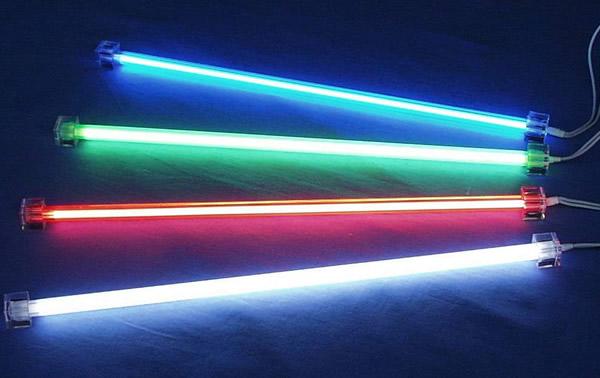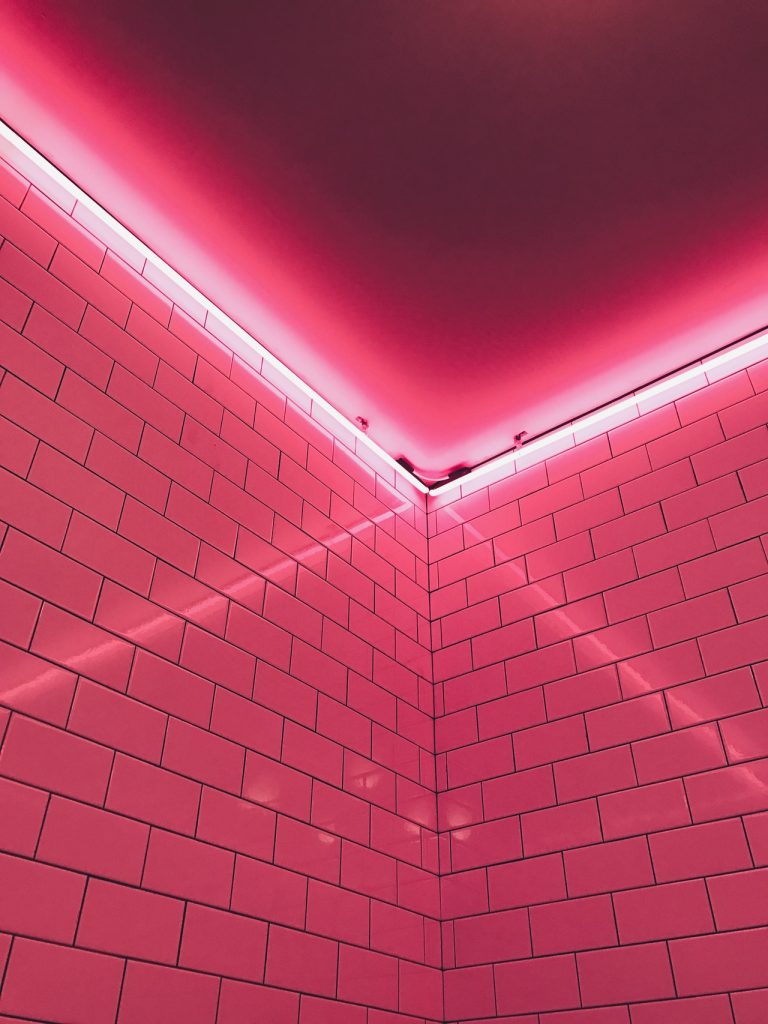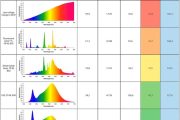How LEDs Produce Colored Light
The luminous color and luminous efficiency of LEDs are related to the materials and processes used to make the LEDs. At present, three colors are widely used: red, green and blue. Due to the low operating voltage of the LED (only 1.5-3V), it can actively emit light and has a certain brightness. The brightness can be adjusted by voltage (or current), and it is resistant to shock, vibration and long life (100,000 hours).
Different materials are used to make LEDs, which can generate photons with different energies, which can control the wavelength, or spectrum or color, of the light emitted by the LED.
The material used in the first LED in history is gallium arsenide (GaAs), and its forward P-N junction voltage drop (VF, which can be understood as lighting or operating voltage) is 1.424V, and the light emitted is in the infrared spectrum. Another commonly used LED material is gallium phosphide (GaP), which has a forward P-N junction voltage drop of 2.261V and emits green light.
Tri-element LED and Quad-element LED
Based on these two materials, the early LED industry used the GaAs1-xPx material structure to theoretically produce LEDs of any wavelength from infrared light to green light. X represents the percentage of phosphorus replaced by arsenic. Generally, the wavelength color of the LED can be determined by the voltage drop of the P-N junction. The typical ones are GaAs0.6P0.4 red LED, GaAs0.35P0.65 orange LED, GaAs0.14P0.86 yellow LED and so on. Since three elements of gallium, arsenic and phosphorus are required to manufacture LED chips, these LEDs are commonly called three-element light-emitting diodes.
GaN (gallium nitride) blue LEDs, GaP green LEDs and GaAs infrared LEDs are collectively referred to as two-element light-emitting tubes. The latest process is a four-element LED made of mixed aluminum (Al), calcium (Ca), lanthanum (In) and nitrogen (N) four-element materials. It can cover all visible light and some ultraviolet light spectral range.
light Intensity:
The measurement units of luminous intensity include illuminance unit (Lux), luminous flux unit (Lumen), and luminous intensity unit (Candle power).
1 CD (candle light) refers to the luminous intensity of a completely radiant object per 1/60th of a square centimeter area at the freezing point temperature of platinum. (It used to refer to a whale oil candle with a diameter of 2.2 cm and a weight of 75.5 grams, which burns 7.78 grams per hour and has a flame height of 4.5 cm. How much light is radiated in the horizontal direction. 1 lumen means that 1 CD candle shines at a distance of 1 cm, the luminous flux on a plane with an area of 1 cm2.
Illuminance (lux)
1 Lux refers to the luminous intensity of the luminous flux of 1Lumen evenly distributed on an area of 1 square meter. The illuminance unit is Lux, which is generally used in photography and other fields. The three measurement units are numerically equivalent, but need to be understood from different perspectives. For example, if the brightness (luminous flux) of an LCD projector is 1600 lumens and the size of its projection onto a total reflection screen is 60 inches (1 square meter), its illuminance is 1600 lux. Assuming that the light outlet is 1 cm away from the light source and the area of the light outlet is 1 square cm, the luminous intensity of the light outlet is 1600CD. In a real LCD projector, the brightness will be greatly reduced due to the loss of light transmission, the loss of reflection or light-transmitting film, and the uneven light distribution. Generally 50% efficiency is good.
Calculation Unit of Luminous Intensity
In practical use, luminous intensity calculation often uses 1 CD/square meter as the luminous intensity unit. And with the observation angle as an auxiliary parameter, it is equivalent to the illuminance unit lux of the screen surface.
Multiply this value by the effective display area of the screen to obtain the luminous intensity of the entire screen at the optimum viewing angle. Assuming that the luminous intensity of each primitive in the screen is constant in the corresponding space, this value can be considered as the luminous flux of the entire screen.
Generally, an outdoor LED screen must reach a brightness of more than 4000 CD/square meter to have an ideal display effect in sunlight. Ordinary indoor LED, the maximum brightness is about 700 ~ 2000 CD/square meter.
The luminous intensity of a single LED is measured in CD, with viewing angle parameters. The luminous intensity has nothing to do with the color of the LED. The luminous intensity of a single tube varies from a few mCD to 5000 mCD.
The luminous intensity given by the LED manufacturer refers to the point where the LED is lit at a current of 20mA, at the best viewing angle and at the point where the luminous intensity is the largest. The shape of the top lens and the position of the LED die from the top lens when the LED is packaged determine the LED viewing angle and light intensity distribution.
The larger the LED viewing angle, the smaller the maximum luminous intensity. However, the accumulated luminous flux on the entire solid hemisphere remains unchanged. When multiple LEDs are arranged closely and regularly, their luminous spheres are superimposed on each other, resulting in a uniform luminous intensity distribution on the entire luminous plane.
Calculation Method of Luminous Intensity
When calculating the luminous intensity of the screen, it is necessary to multiply the maximum point luminous intensity value provided by the manufacturer by 30% to 90% according to the LED viewing angle and the emission density of the LED, as the average luminous intensity of a single tube.
Generally, the luminous life of LED is very long, and the manufacturer generally indicates that it is more than 100,000 hours. In fact, we should also pay attention to the brightness decay period of LEDs. For example, after most of the UR red tubes used in automobile taillights are lit for ten to dozens of hours, the brightness is only half of the original.
The brightness decay period has a lot to do with the production material of the LED. Generally, four-element LEDs with slower brightness decay should be used when economic conditions permit.
Color Matching, White Balance:
White is a mixture of red, green, and blue in proportion to their brightness. When the brightness of green is 69%, the brightness of red is 21%, and the brightness of blue is 10%, the human eye perceives pure white after color mixing. However, the chromaticity coordinates of LED red, green and blue cannot achieve the effect of full chromatogram due to the manufacturing process and other reasons. Therefore, white light is obtained by controlling the brightness of the primary colors including the deviated primary colors, which is called color matching.
Before color matching for a full-color LED screen, in order to achieve the best brightness and the lowest cost, you should try to choose the three-primary color luminous intensity into a roughly 3:6:1 ratio of LED devices to form pixels.
Three Primary Colors – Red, Green, Blue
White balance requires that the three primary colors synthesized under the same gray value are still pure white.
Primary color, base color:
Primary colors refer to the basic colors that can be synthesized into various colors. The primary colors in color light are red, green, and blue. The three vertices in the spectral table are ideal primary color wavelengths. If the primary colors are biased, the area of synthesizable colors is reduced and the triangles in the spectral table are reduced. From a visual point of view, the color will not only be biased, but also less rich.
Multiple color generation
The red, green and blue light emitted by LEDs are roughly divided into purple, pure red, orange-red, orange, orange-yellow, yellow, yellow-green, pure green, emerald green, blue-green, pure blue, blue-violet, etc. according to their different wavelength characteristics. Orange-red, yellow-green, and blue-purple are much cheaper than pure red, pure green, and pure blue.
Of the three primary colors, green is the most important, as it provides 69% of the brightness and is at the center of the horizontal arrangement of colors. Therefore, when weighing the three-primary color composition between color purity and price, the usual practice in three-primary design applications is to adjust the set LED current to achieve white balance and maximum desired brightness value.
LED color matching
We generally take the simplest and most optimized color matching method as the color rendering method for designing full-color display technology. White balance is one of the important criteria for testing color composition. The three primary colors of white light are generally red, green and blue, which are mixed according to the ratio of brightness. When the brightness of green in the light is 69%, the brightness of red is 21%, and the brightness of blue is 10%, the human eye perceives pure white after color mixing. Earlier CRT TVs and now LCD liquid crystal displays are all composed in this way.






